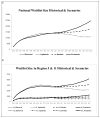Trends in Characteristics of Patients Listed for Liver Transplantation Will Lead to Higher Rates of Waitlist Removal Due to Clinical Deterioration
- PMID: 28858174
- PMCID: PMC5667556
- DOI: 10.1097/TP.0000000000001851
Trends in Characteristics of Patients Listed for Liver Transplantation Will Lead to Higher Rates of Waitlist Removal Due to Clinical Deterioration
Abstract
Background: Changes in the epidemiology of end-stage liver disease may lead to increased risk of dropout from the liver transplant waitlist. Anticipating the future of liver transplant waitlist characteristics is vital when considering organ allocation policy.
Methods: We performed a discrete event simulation to forecast patient characteristics and rate of waitlist dropout. Estimates were simulated from 2015 to 2025. The model was informed by data from the Organ Procurement and Transplant Network, 2003 to 2014. National data are estimated along with forecasts for 2 regions.
Results: Nonalcoholic steatohepatitis will increase from 18% of waitlist additions to 22% by 2025. Hepatitis C will fall from 30% to 21%. Listings over age 60 years will increase from 36% to 48%. The hazard of dropout will increase from 41% to 46% nationally. Wait times for transplant for patients listed with a Model for End-Stage Liver Disease (MELD) between 22 and 27 will double. Region 5, which transplants at relatively higher MELD scores, will experience an increase from 53% to 64% waitlist dropout. Region 11, which transplants at lower MELD scores, will have an increase in waitlist dropout from 30% to 44%.
Conclusions: The liver transplant waitlist size will remain static over the next decade due to patient dropout. Liver transplant candidates will be older, more likely to have nonalcoholic steatohepatitis and will wait for transplantation longer even when listed at a competitive MELD score. There will continue to be significant heterogeneity among transplant regions where some patients will be more likely to drop out of the waitlist than receive a transplant.
Conflict of interest statement
Similar articles
-
Effect of Mandatory 6-Month Waiting Period on Waitlist and Transplant Outcomes in Patients With Hepatocellular Carcinoma.Hepatology. 2020 Dec;72(6):2051-2062. doi: 10.1002/hep.31223. Epub 2020 Oct 22. Hepatology. 2020. PMID: 32157711
-
Outcomes for liver transplant candidates listed with low model for end-stage liver disease score.Liver Transpl. 2015 Nov;21(11):1403-9. doi: 10.1002/lt.24307. Liver Transpl. 2015. PMID: 26289624 Free PMC article.
-
Variation in access to the liver transplant waiting list in the United States.Transplantation. 2014 Jul 15;98(1):94-9. doi: 10.1097/01.TP.0000443223.89831.85. Transplantation. 2014. PMID: 24646768 Free PMC article.
-
Update on the management of the liver transplant patient.Curr Opin Gastroenterol. 2015 May;31(3):224-32. doi: 10.1097/MOG.0000000000000173. Curr Opin Gastroenterol. 2015. PMID: 25774445 Review.
-
Adult Liver Allocation in Eurotransplant.Transplantation. 2017 Jul;101(7):1542-1550. doi: 10.1097/TP.0000000000001631. Transplantation. 2017. PMID: 28060242 Review.
Cited by
-
Incidence and Impact of Acute Kidney Injury after Liver Transplantation: A Meta-Analysis.J Clin Med. 2019 Mar 17;8(3):372. doi: 10.3390/jcm8030372. J Clin Med. 2019. PMID: 30884912 Free PMC article.
-
Patients With Persistently Low MELD-Na Scores Continue to Be at Risk of Liver-related Death.Transplantation. 2020 Jul;104(7):1413-1418. doi: 10.1097/TP.0000000000002997. Transplantation. 2020. PMID: 31644488 Free PMC article.
-
Liver Transplantation for Nonalcoholic Steatohepatitis: Pathophysiology of Recurrence and Clinical Challenges.Dig Dis Sci. 2019 Dec;64(12):3413-3430. doi: 10.1007/s10620-019-05716-1. Epub 2019 Jul 16. Dig Dis Sci. 2019. PMID: 31312990 Review.
-
Ethnic and Age Disparities in Outcomes Among Liver Transplant Waitlist Candidates.Transplantation. 2019 Jul;103(7):1425-1432. doi: 10.1097/TP.0000000000002523. Transplantation. 2019. PMID: 30418427 Free PMC article.
-
Prediction of Perioperative Mortality of Cadaveric Liver Transplant Recipients During Their Evaluations.Transplantation. 2019 Oct;103(10):e297-e307. doi: 10.1097/TP.0000000000002810. Transplantation. 2019. PMID: 31283673 Free PMC article.
References
-
- Su F, Yu L, Berry K, et al. Aging of liver transplant registrants and recipients: trends and impact on waitlist outcomes, post-transplantation outcomes, and transplant-related survival benefit. Gastroenterology. 2016;150(2):441–453. e446. - PubMed
-
- Yi Z, Mayorga M, Wheeler SB, Hayashi PH, Barritt AS, Orman ES. The numbers of new waitlist registrants and removals are outpacing the number of liver transplants: national trends and regional variation from 2003 through 2014. Abstract presented at: AASLD Liver Meeting; November 13, 2016.2016.
MeSH terms
Grants and funding
LinkOut - more resources
Full Text Sources
Other Literature Sources
Medical



